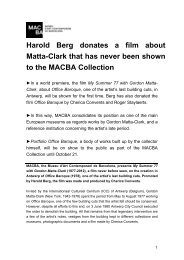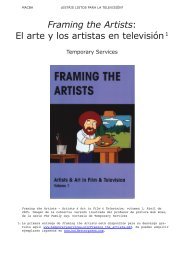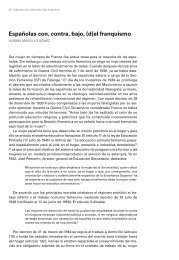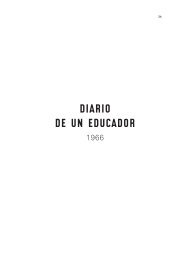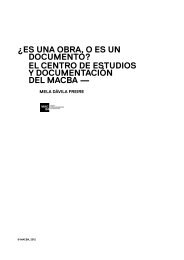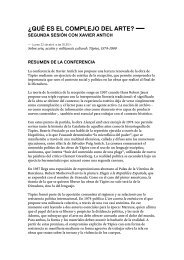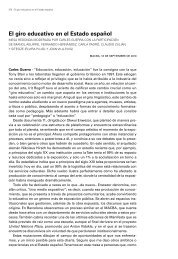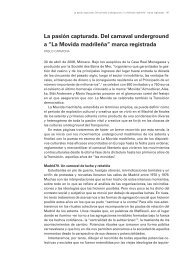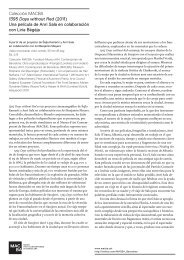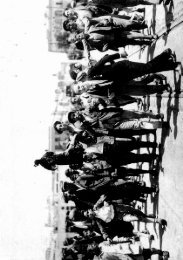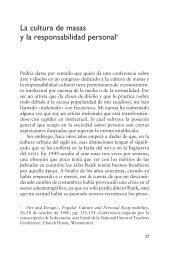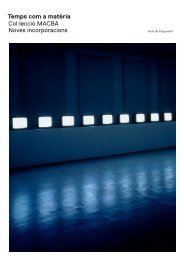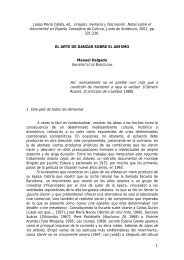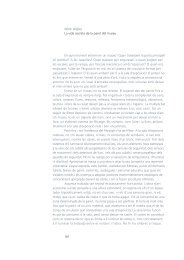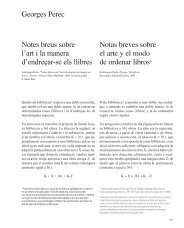Chance, Indeterminacy, Multiplicity - Macba
Chance, Indeterminacy, Multiplicity - Macba
Chance, Indeterminacy, Multiplicity - Macba
Create successful ePaper yourself
Turn your PDF publications into a flip-book with our unique Google optimized e-Paper software.
44. John Cage, [“Dartmouth Spring<br />
’55“], folder 10, box 12, John Cage<br />
Papers, Collection 1000-72, Special<br />
Collections and Archives, Olin Library,<br />
Wesleyan University, Middletown,<br />
Conn.; cited in Kim, p. 221. Kim<br />
also mentions Earle Brown’s citation<br />
of Bergson, p. 97.<br />
45. Bergson, pp. 232–33.<br />
46. Ibid., p. 230. Around 1954, Cage<br />
began to echo Bergson’s notion of duration<br />
as, not an abstract or mechanical<br />
expanse of time, but a subjectively lived<br />
temporality in relation to the world<br />
around: “Time… is what we and sounds<br />
happen in. Whether early or late: in it.<br />
It is not a question of counting.” (Cage,<br />
“45’ for a Speaker,” p. 151).<br />
47. Bergson, pp. 38–40. On the different<br />
types of multiplicity, see Gilles Deleuze,<br />
Bergsonism, Hugh Tomlinson and<br />
Barbara Habberjam, (trans.), New York:<br />
Zone Books, 1988 p. 37–41.<br />
48. Bergson, p. 234.<br />
49. John Cage, “Letter to Paul Henry<br />
Lang” (1956), in Kostelanetz, (ed.),<br />
John Cage: An Anthology, p. 118. Cage<br />
explicitly opposes the “natural” and<br />
“anthropomorphic” points of view in<br />
Cage, “On Film” (1956), in Kostelanetz,<br />
(ed.), John Cage, p. 115. For Bergson’s<br />
critique of dialectics, see, for example,<br />
Bergson, p. 238. Cage is, as a thinker,<br />
like Bergson in Deleuze’s description<br />
of him: not one who ascribes to “a properly<br />
human wisdom and equilibrium,”<br />
but one who attempts to “open us up to<br />
the inhuman and the superhuman (durations<br />
which are inferior or superior to<br />
our own), to go beyond the human condition.”<br />
(Deleuze, Bergsonism, p. 28.)<br />
has said) an order we had not been looking for.” 44 Bergson’s<br />
critique of disorder was also found in Creative Evolution and<br />
proceeded in the same manner as his critique of nonbeing. As<br />
alluded to in Cage’s paraphrase, Bergson considered disorder to<br />
be a pseudo-idea that arose on account of the disappointment<br />
of an individual who, searching for one kind of order, finds<br />
another. “When I enter a room and pronounce it to be ‘in disorder,’<br />
what do I mean?” queried Bergson:<br />
The position of each object is explained by the automatic movements of<br />
the person who has slept in the room, or by the efficient causes, whatever they may<br />
be, that have caused each article of furniture, clothing, etc., to be where it is: the<br />
order, in the second sense of the word, is perfect. But it is order of the first kind<br />
that I am expecting, the order that a methodical person consciously puts into his<br />
life, the willed order and not the automatic: so I call the absence of this order<br />
“disorder.” At bottom, all there is that is real, perceived and even conceived, in<br />
this absence of one of the two kinds of order, is the presence of the other. But the<br />
second is indifferent to me, I am interested only in the first, and I express the presence<br />
of the second as a function of the first, instead of expressing it, so to speak,<br />
as a function of itself, by saying it is disorder. 45<br />
If one type of order was that expressed in scientific, geometric,<br />
mechanistic, and/or mathematical laws (an order predicated<br />
on suppressing lived duration), the second was a “vital” one that<br />
existed within duration’s continual flow and was “essentially<br />
creation.” 46 To each type of order corresponded a certain type of<br />
multiplicity. One form was proper to discontinuous, numerical<br />
multiplicities, the other to continuous, virtual multiplicities, those<br />
integrally related to the creative transformations of lived duration.<br />
47 According to Bergson (in a connection that would not have<br />
gone unnoted by Cage) the idea of chance as a form of disorder<br />
was prompted by the confusion of an individual who failed to<br />
grasp the difference between these two types of order. “…in reality,”<br />
wrote Bergson, “chance merely objectifies the state of mind<br />
of one who, expecting one of the two kinds of order, finds himself<br />
confronted with the other. <strong>Chance</strong> and disorder are therefore<br />
necessarily conceived as relative.” 48<br />
Like Bergson, Cage sought to think in a non-“anthropomorphic”<br />
manner, to grasp the “life” that, as he explained to Paul Henry<br />
Lang, “goes on very well without me” – an order of existence that<br />
surpasses the limitations of the human mind and the procedures<br />
of dialectical thinking that Cage saw as derived from it. 49 It was for<br />
this reason that he mobilized the idea of multiplicity (as a complex<br />
interaction that was in line with the actual, ontological existence<br />
of sound) against an idea of relationships as generally understood<br />
221



